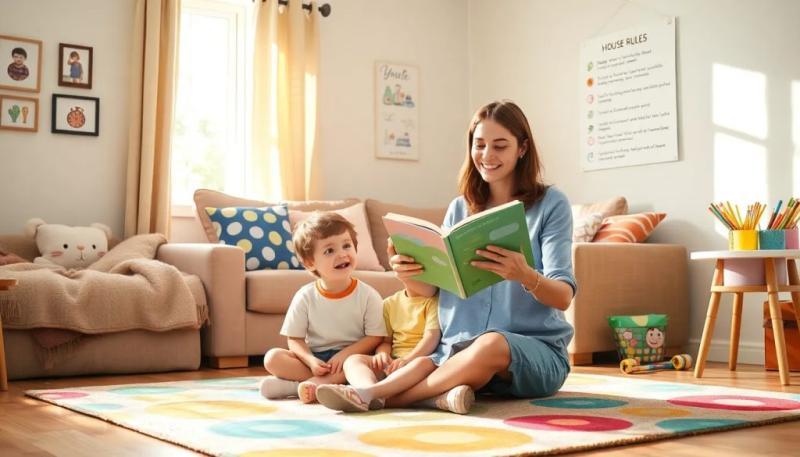Establishing clear and consistent house rules is fundamental for successful babysitting. When parents and babysitters communicate effectively, it creates a positive environment for everyone involved. Understanding how babysitters manage house rules is crucial for ensuring safety and well-being of children.
In this article, we will delve into various aspects of babysitting, focusing on the essential rules and communication strategies that help create a harmonious babysitting experience.
What are the essential rules for babysitting in your home?
Setting house rules is a vital part of the babysitting process. These rules can include guidelines related to safety, behavior, and routines that both the babysitter and children must follow.
- Keep emergency contacts handy: Ensure the babysitter knows whom to contact in case of an emergency.
- Limit screen time: Establish rules regarding the use of electronic devices during babysitting hours.
- Discuss dietary restrictions: Make sure the babysitter is aware of any allergies or food restrictions.
- Designate play areas: Define which areas of the house are off-limits to maintain safety.
These rules help set clear expectations and contribute to a secure environment. Additionally, it is important for parents to discuss the rationale behind these rules with the babysitter, ensuring everyone is on the same page.
How can parents communicate house rules to a babysitter effectively?
Effective communication plays a significant role in how babysitters manage house rules. Parents can ensure clarity and understanding by following these tips:
- Provide a written list: A checklist of rules can serve as a quick reference for babysitters.
- Discuss expectations: Have a conversation before the babysitting begins to address any questions or concerns.
- Encourage feedback: Ask the babysitter for input on rules or guidelines to foster collaboration.
Clear communication not only aids in compliance with house rules but also builds trust between parents and caregivers. By establishing a dialogue, parents can create a positive babysitting environment where everyone feels comfortable and respected.
What are the unwritten rules of babysitting that every sitter should know?
Aside from the explicit house rules, there are several unwritten rules that can enhance the babysitting experience. These may not be formally communicated but are often understood within the context of caregiving.
Respect privacy: Babysitters should be discreet and respectful of the family’s private space, avoiding rummaging through personal belongings.
Be adaptable: Every family has its unique dynamics, and babysitters should be flexible in adjusting to different routines and preferences.
- Follow the house’s rhythm, whether it's mealtimes or nap schedules.
- Maintain a positive attitude, as children often mirror the emotional state of their caregivers.
- Encourage creativity in play, allowing children to explore and engage in imaginative activities.
Understanding these unwritten rules can greatly improve the relationship between parents and babysitters, leading to a smoother experience for everyone involved.
How do babysitters manage house rules to ensure safety?
Safety is a top priority in babysitting. Babysitters manage house rules to create a safe environment through various strategies:
First and foremost, they must be familiar with the child care safety protocols established by the parents. This includes knowing basic emergency procedures and the location of first aid supplies.
Moreover, babysitters should always be vigilant about potential hazards, such as keeping sharp objects out of reach and ensuring that play areas are free of dangerous items. Regularly checking on children during playtime is also essential.
- Keep medications stored securely.
- Use child-proof locks on cabinets and doors as needed.
- Stay informed about any allergies or medical conditions the children may have.
By prioritizing safety, babysitters can effectively manage the house rules and provide a secure environment for children while they are in their care.
What are the key areas of effective communication with babysitters?
Effective communication encompasses several key areas that parents should focus on when engaging with babysitters:
Daily routines: Parents should clearly outline the children’s daily schedules, including meal times, nap times, and play periods. This helps babysitters maintain consistency, which is important for children.
Behavior expectations: Discuss acceptable and unacceptable behaviors. Being clear about discipline strategies helps babysitters manage children's behavior effectively.
- Emergency procedures: Ensure babysitters are aware of what to do in case of an emergency, including fire drills or medical emergencies.
- Household rules: Go over any specific rules, such as “no shoes on the carpet” or “do not use the stove.”
These areas of communication help build a foundation of trust and understanding, allowing babysitters to feel confident in their role.
How can parents prepare their children for a babysitter's arrival?
Preparing children for a babysitter can ease their transition and help them feel more comfortable. Here are some effective strategies:
Introduce the babysitter beforehand: If possible, arrange a meet-and-greet before the babysitting occurs. This helps children become familiar with the caregiver and reduces anxiety.
Additionally, parents can explain the babysitter's role and what to expect during their time together. This might include discussing activities or games they can play.
- Encourage children to ask questions about the babysitter.
- Share fun facts about the babysitter to create excitement.
- Reassure children that they will be safe and cared for.
By preparing children adequately, parents can help ensure a smoother babysitting experience for everyone involved.
What should parents leave for the babysitter to ensure a smooth experience?
To facilitate a successful babysitting experience, parents should consider leaving the following items for the babysitter:
Detailed instructions: Include notes on routines, preferences, and any specific rules that need to be followed. This ensures that the babysitter can manage house rules effectively.
Emergency contact information: Provide a list of numbers, including neighbors, family members, and local emergency services.
- Snacks and meals: Have meals or snacks ready to minimize confusion during mealtimes.
- First aid kit: Ensure the babysitter has access to a first aid kit and understands how to use it.
- Entertainment options: Leave toys, games, or crafts that are suitable for the children's age to keep them engaged.
These preparations can make a significant difference in how well babysitters manage house rules and ensure a positive experience for children.
Questions related to babysitting and house rules
How to set boundaries while babysitting?
Setting boundaries while babysitting requires clear communication and consistent enforcement. Babysitters should understand the rules established by parents and feel empowered to enforce them. It's important for babysitters to maintain a calm and authoritative demeanor when addressing behavior issues. This approach helps children understand the consequences of their actions and reinforces the importance of respecting boundaries.
How much to pay a babysitter in Nebraska?
The pay for babysitters in Nebraska can vary based on several factors, including experience, number of children, and the location. Typically, the average rate ranges from $12 to $20 per hour. It's advisable for parents to discuss payment openly with babysitters, ensuring that both parties feel comfortable with the agreement. Additionally, parents can consider offering a higher rate for special circumstances, such as late-night care or multiple children.
What are the three biggest responsibilities of a babysitter?
The three biggest responsibilities of a babysitter typically include ensuring the children’s safety, providing care and supervision, and managing daily routines. Safety involves monitoring children closely and being prepared for emergencies. Providing care includes engaging children in activities, helping with meals, and ensuring they adhere to established house rules. Finally, managing routines means keeping track of children’s schedules, including playtime, meals, and bedtime.
What rules should I have as a babysitter?
As a babysitter, it is essential to have rules in place that promote safety and respect. Some key rules might include no running in the house, respecting the parents' directives regarding screen time, and maintaining a respectful tone when communicating with the children. Additionally, it's crucial to report any issues or concerns to the parents for further guidance. Establishing these rules helps create a structured environment where children feel secure and cared for.



